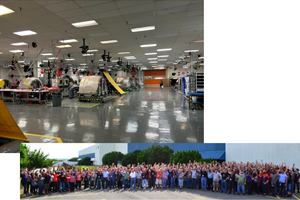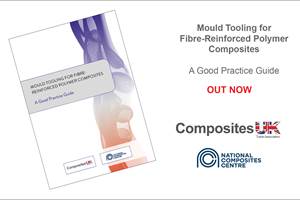CompositesWorld News for Dec. 27, 2019
Read news from Boston Materials, Gurit UK, Thermwood, Society for the Advancement of Material and Process Engineering (SAMPE), and Lockheed Martin Aeronautics
Shin-Etsu Chemical Co. to manufacture, market new hydrocarbon resins for 5G electronics, aerospace
Developed per a licensing agreement with materials company Novoset LLC, the resins are said to possess ultra-low dielectric loss properties for electronics.

Materials company Novoset LLC (Peapack, New Jersey, U.S.) announced on Dec. 26 that it has signed a licensing agreement with Shin-Etsu Chemical Co. Ltd. (Tokyo, Japan) for the manufacturing and marketing of modified hydrocarbon resins based on Novoset’s intellectual property, which will target applications in electronics, automotive and aerospace.
The new resins are said to exhibit ultra-low dielectric loss properties at high frequencies, low coefficient of thermal expansion (CTE), very low moisture absorption, high glass transition temperatures (Tg) and long-term thermo-oxidative stability at 250°C.
These products are targeted for a range of 5G applications such as chip encapsulation, underfill, molding compounds, millimeter wave base station infrastructure for smartphones, high layer count printed circuit board (PCB) servers, routers for cloud computing and semiconductor packaging. Novoset says that these resins are specifically designed for use in devices enabling next-generation 5G technologies like Advanced Driver Assistance Systems (ADAS).
These products are also reportedly suitable for various aerospace applications where ultra-low dielectric, low moisture properties and high Tg are required. In addition, the materials can be used in aerospace processes such as resin infusion, hot melt prepreg, filament winding and other liquid processes.
Novoset officials said in a press release, “We are pleased to collaborate with Shin-Etsu Chemical, Japan to commercialize these unique products to address material gaps and difficult-to-process current 5G materials (targeted to millimeter wave substrates, antennas) such as liquid-crystal polymers (LCP), polyimides (PI) and polytetrafluorethylene (PTFE). Shin-Etsu Chemical is our ideal collaborator due to their in-house 5G applications and global footprint in semiconductors and other high-end industries.”
The resins were developed at Novoset Technology Center in Berkeley Heights, N.J., U.S. Under this agreement, Shin-Etsu Chemical Co. Ltd. will manufacture the resins globally in the relevant electronics industries and market the products under SLK name. Novoset will market the products in aerospace, oil and gas, and other industries, and will continue to improve and expand the range of products according to market needs.
AFRL camber morphing wing takes flight
Smooth composite skin enables active re-contour of up to 6% and fuel savings of 10%.
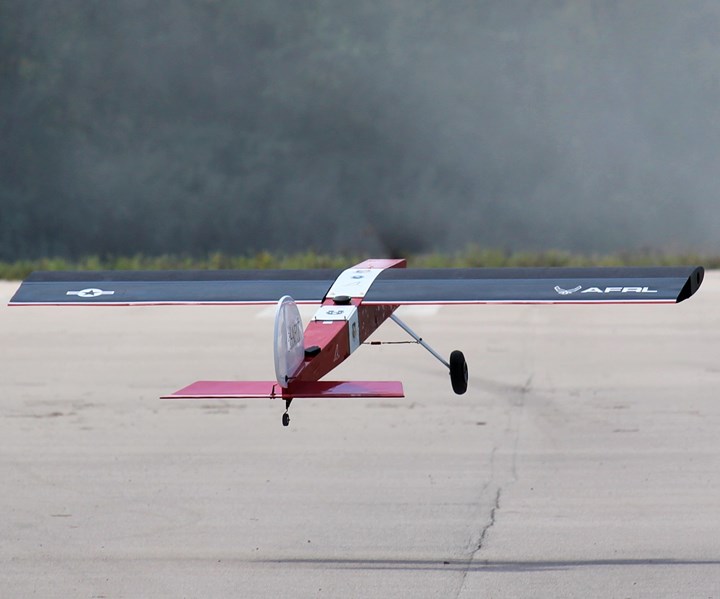
The Air Force Research Laboratory (AFRL, Wright-Patterson Air Force Base, Ohio, U.S.) recently completed the successful flight demonstration of a game-changing camber morphing wing technology that could significantly increase aircraft range and performance.
The AFRL-developed Variable Camber Compliant Wing (VCCW) is capable of changing shape to improve aerodynamic performance and morph itself to various flight conditions and missions. Wing camber, or the shape of a wing surface, is a fundamental element of aerodynamic flight. Conventional wings with discrete hinged control surfaces have greater drag, whereas wings with a smooth camber are efficient and maneuverable. The ability to morph the wing according to aerodynamic conditions would give an aircraft increased lift when needed without a weight penalty — typically at takeoff and landing — and greater fuel-efficiency and maneuverability when in flight.
This flight experiment demonstrated the second iteration of the VCCW, a smaller, more compact version than the first, which was used primarily in wind tunnel experiments. This eight-foot wing was designed to be flown on a commercial-off-the-shelf remotely controlled aircraft, simulating an unmanned air vehicle. During the series of flights, held in September and October 2019, the wing was flown at low speeds, completing a number of maneuvers and demonstrating active shape control for optimized drag reduction and increased agility.
Single-piece, composite skin
The VCCW features smooth and continuous skin construction, which not only reduces noise by eliminating sharp surfaces and gaps, but improves aerodynamic performance as well. According to Dr. James Joo, AFRL Advanced Structural Concepts team lead and VCCW program manager, the improved aerodynamics translates into potentially significant fuel savings.
“Early estimates show VCCW technology saving aircraft fuel consumption by 10 percent,” said Joo. “This was one of our main goals, and it fits the Air Force’s efforts to reduce overall energy costs.”
According to a Dec 2019 article in TechBriefs.com:
“The wing can actively re-contour the airfoil camber up to 6% and the entire skin is seamless, continuous, and made of a single-piece, non-stretchable composite skin. Smooth conformal shape of the wing is attained by distributed elastic deformation from the underlying compliant mechanism and 3D shape change is also capable through variation of camber along the spanwise direction using a distributed actuation system along the span. Single actuation control for both leading and trailing edge deflection is another very unique aspect of VCCW compared to previous technologies. It was fabricated using advanced manufacturing technology enabling a solution that is lightweight, low power, and low cost.”
Advancing flexible wing technology
Jared Neely, AFRL research engineer and designer of the morphing wing, called this demonstration an important step in advancing flexible wing technology for warfighter use.
“The success of this demonstration has given us confidence that this technology can be leveraged to higher-class vehicles, to take advantage of the many benefits this technology can truly offer.”
Joo added that although other research organizations have explored the morphing camber concept, AFRL’s version is unique because it is a true flexible wing without any discrete control surfaces to assist in takeoff and landing. This seamless surface can increase overall range, making it ideal for a variety of long-range platforms. He says the team will continue to refine the concept and look into additional ways it can benefit existing aircraft.
“We are excited about the success of this demonstration,” said Joo. “We are continuing to explore the opportunities that this technology can offer for future Air Force aircraft development.”
Researchers develop carbon nanotube heat shield
A team of researchers from Florida State University is developing a design for for a carbon nanotube-based heat shield for use on satellites, rockets and jet aircraft.

Professor Zhiyong (Richard) Liang and research faculty member Ayou Hao holding pieces of carbon fiber-reinforced polymer composites with a protective heat shield made of a carbon nanotube sheet that was heated to a temperature of 1,900°C. Source | FSU
A team of researchers from Florida State University’s High-Performance Materials Institute (HPMI; Tallahassee, Fla., U.S.) is developing a design for for a carbon nanotube-based heat shield for use on satellites, rockets and jet aircraft. Their work is published in the November 2019 edition of the journal CARBON.
The team used sheets of carbon nanotubes (see CW’s primer on nanomaterial types and definitions) to build the heat shields. These sheets, also known as “buckypaper,” were soaked in a phenol resin to create a lightweight, flexible material that reportedly durable enough to protect the body of a rocket or jet from the intense heat it faces while flying.
According to Ayou Hao, a research faculty member at HPMI, existing heat shields are often very thick compared to the base they protect, while this design lets engineers build a very thin shield, like a sort of skin that protects the aircraft and helps support its structure.
After building heat shields of varying thicknesses, the researchers put them through several tests. One test involved applying a flame to the samples to see how they prevented heat from reaching the carbon fiber layer they were meant to protect. After that, the researchers bent the samples to see how strong they remained.
They found the samples with sheets of buckypaper were better than control samples at dispersing heat and keeping it from reaching the base layer. They also stayed strong and flexible compared to control samples made without protective layers of nanotubes. According to the researchers, the flexibility of the nanotubes means the sheets are less vulnerable to cracking at high temperatures compared to ceramics, a typical heat shield material. They are also lighter weight compared to traditional materials.
The project received second place among peer-reviewed posters at the 2019 National Space and Missile Materials Symposium and received third place at the Society for the Advancement of Material and Process Engineering 2019 University Research Symposium.
The project was partially supported by teh U.S. Air Force Office of Scientific Research.
People in Composites: December 2019
Boston Materials, Composites UK, Gougeon Brothers, Gurit, Nano Dimension, SAMPE, Shape and Thermwood announce new hires and retirees in the composites manufacturing industry.
Boston Materials hires new technical sales manager
Boston Materials Inc. (Bedford, Mass., U.S.) has announced the hire of Karl Hawes as Technical Sales Manager. Hawes joins the company with more than fifteen years of composites industry experience in general management, sales, manufacturing and business development and a strong understanding of the aerospace and industrial composites markets. Hawes will work with Boston Materials to drive new business development and sales revenue growth of the company’s Supercomp 3D carbon fiber product line.
Previously, Hawes was the General Manager of Nammo Composite Solutions, where he was responsible for oversight of both operations and engineering, establishing new product lines, and setting the strategy for what resulted in triple top-line revenue growth of the business unit. He has expertise in composites and textiles and held leadership positions at ITT and Quaker Fabrics. Most recently, he was General Manager at Eclipse Composites Engineering. Karl has a B.A. in economics and has been recognized by Utah Business Magazine as “Sales and Marketer” of the year.
Composites UK announces new construction group chair
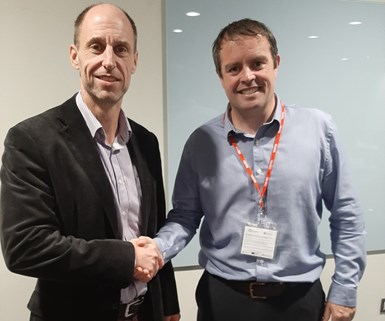
Source | Composites UK
Allan Curtis of Design and Display Structures Ltd. (London, U.K.) has been announced as the new chair of the Composites UK Construction Sector Group (Berkhamsted, U.K.). The announcement comes after the group’s last meeting on Dec. 3, 2019.
Curtis brings more than 30 years’ experience in the construction industry, initially in high-end curtain walling systems before transferring his skills over to glass-reinforced polymer (GRP) cladding in 1994. He is currently owner and director of Design & Display Structures, a company he has developed into a market leader providing bespoke ‘design and build’ package solutions.
He takes over the role from James Henderson of Atkins Ltd., who now chairs the Composites Leadership Forum’s (CLF) construction group.
“I am delighted to receive this opportunity to work alongside industry colleagues to raise awareness of the wide range of benefits composites can offer to construction projects, end clients and the professionals working within it,” Curtis says.
Gougeon Brothers expands sales and marketing teams

Eric Heilshorn. Source | Gougeon Brothers
Epoxy manufacturer Gougeon Brothers Inc. (GBI; Bay City, Mich., U.S.) has recently added two new members to its growing sales and marketing teams.
Eric Heilshorn has joined the company’s outside sales department to handle sales of PRO-SET and PRO-VAC USA Vacuum Bagging Consumables in the Western region of the United States. According to Gougeon Brothers, Heilshorn’s long marine industry career in design engineering and manufacturing make him uniquely qualified to assist GBI clients with their composite manufacturing projects. He comes from 3A Composites (High Point, N.C., U.S.), where he managed four primary product lines and 30 different product offerings in the North American market. Prior to that he spent several years as the Northern Regional Sales manager for Vectorply Corp. (Phenix City, Ala., U.S.), where he strengthened supplier-distributor relationships from the Mid-West to Eastern Canada. He holds a Bachelor of Science degree from Plymouth State College and a Certificate of Design from The Landing School in Arundel, Maine.

Tyler Pier. Source | Gougeon Brothers
Tyler Pier is the newest member of the growing GBI marketing department. He will spearhead all digital marketing efforts including SEO and social media, with special focus on entropy resins and WEST SYSTEM. He earned a Bachelor of Business degree from Western Michigan University and gained digital marketing experience working at closed-cell foam manufacturer Sekisui Voltek.
Gurit composite materials general manager to leave in 2020
Gurit (Zurch, Switzerland) announced on Dec. 20 that Stefan Gautschi, general manager of composite materials, will leave Gurit by June 2020 to assume another professional opportunity outside the advanced composites industry. According to Gurit, Gautschi joined the company in 2013 and made strong contributions to the development and growth of the composite materials business unit.
Nano Dimension appoints new president and CEO
Additive electronics manufacturing provider Nano Dimension Ltd. (Ness Ziona, Israel) has appointed Yoav Stern as president and CEO effective Jan. 2, 2020. He will be succeeding the co-founder and current CEO Amit Dror, who is taking the executive role of Customer Success Officer reporting directly to Stern. Dror will also continue to serve as a director on the company’s Board of Directors.
According to the company, Stern is a seasoned executive with a proven track record spanning decades in operating roles as CEO and chairman as well as an active hand-on investor in high-tech companies, specializing in machine vision, fiber optics, defense-tech, communication solutions, aerospace and homeland security. Stern spent most of his operating career in the U.S., running both public and private companies with global operations.
Stern has a B.Sc. degree in Mathematics and Computer Science, a Diploma in Automation and Mechanical Engineering and an M.A. in International Relations from NYU.
“The Board is pleased to have attracted a proven turnaround executive of Mr. Stern’s caliber to lead Nano Dimension,” says Avi Reichental, Chairman of the Board of Nano Dimension. “Throughout his career, Yoav successfully transitioned several promising advanced-tech companies into scalable growth, and that is exactly what Nano Dimension needs at this stage. We are very grateful to Amit Dror, co-founder and current CEO who together with the Board ably initiated and led the search for his successor, and will remain part of the company’s leadership team, serving as Customer Success Officer.”
SAMPE CEO and executive director announces retirement
After serving as CEO and executive director for 16 years, Gregg Balko plans to retire from the Society for the Advancement of Material and Processing Engineering North America (SAMPE, Diamond Bar, Calif., U.S.) in July 2020. SAMPE leadership has formed a committee to search for a successor.
Shape Machining Ltd. expands workforce
Shape Machining Ltd (Oxfordshire, U.K.) announced on Dec. 23 that it has increased its workforce by employing additional pattern makers, which the company says will result in reduced lead times and quicker reactivity to tight deadline RFQ’s.
“Having additional highly skilled people with experience within the F1 industry has allowed increased capacity for car build, and we hope to continue adding to this in 2020,” says Ryan Muller, managing director.
“As well as additional direct staff, we now also have a dedicated scheduling team liaising with shop floor management, guaranteeing increased workflow in the business as well as better communication,” Muller adds. “This has allowed for a reduced scrap rate as well as ensuring the customers’ requirements are relayed from the office to the shop floor.”
Thermwood announces new promotions
Large-scale additive manufacturing (LSAM) and CNC router specialist Thermwood Corp. (Dale, Ind., U.S.) is celebrating its 50th anniversary as well as recent growth, including six new promotions announced this month.
Executive vice president
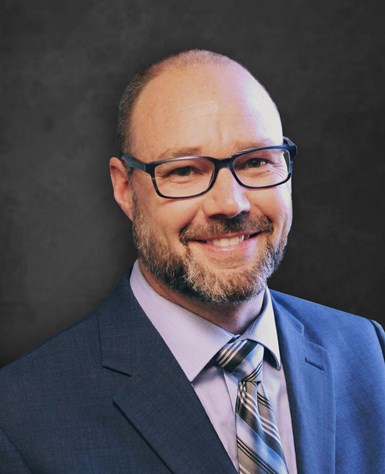
Jason Susnjara. Source | Thermwood
Jason Susnjara has been promoted to the role of Executive Vice President. Susnjara has been with Thermwood since 1995 and has held numerous positions, most recently as Vice President of Marketing. He is also on Thermwood’s Board of Directors. In this new position, he will oversee and manage Thermwood’s technology, engineering, manufacturing and marketing operations.
Vice president of product development
Brian Smiddy has been promoted to the role of Vice President of Product Development. He has been with Thermwood since 1995 and has managed the engineering department over the past 17 years. In this new position, Smiddy will be responsible for new technology development and incorporation of that technology into Thermwood’s product line and production processes. In the past three years, Smiddy has assisted in activities that have generated more than 50 patents on new technical developments. In his new position, he will be able to focus more directly on these activities.
Vice president of software development

Larry Epplin. Source | Thermwood
Larry Epplin has been promoted to the role of Vice President of Software Development. He has been with Thermwood since 2000, developing and managing the company’s cabinet design software products. In this new position, Epplin will manage the development of Thermwood’s software product line, including integrating a type of artificial intelligence into Thermwood’s CNC control so that cabinet makers can produce and almost unlimited number of products without needing a CNC programmer. He will also oversee continued development of Thermwood’s industrial 3D printing software and manage a network of thousands of cabinet shops currently using Thermwood software to design their products and run their shops.
Vice president of marketing
Duane Marrett has been promoted to the role of Vice President of Marketing. Marrett’s career at Thermwood began in 1998 in the engineering department as a technical writer, and has since held positions with increasing responsibilities in various marketing functions. In his most recent position, he developed and managed the company website, interacted with traditional and social media along with creating promotional videos, issuing product releases and conducting market analytics for the company. In Marrett’s new position, he will manage Thermwood’s overall marketing function, including development and execution of trade show exhibitions around the world and overall management of company functions.
Manager of engineering
John Fuquay has been promoted to the role of Manager of Engineering. He has been with Thermwood since 2003 in engineering, designing products and providing documentation for production. In his new position, Fuquay will manage the engineering department, implementing new product designs, maintaining the extensive engineering database and providing engineering support to manufacturing.
Chief legal officer
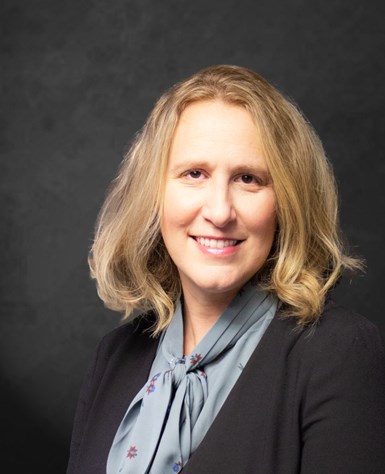
Jessica Watt. Source | Thermwood
Jennifer Watt has been promoted to the role of Chief Legal Officer, Secretary and Vice President. In this role, Watt has oversight of all legal aspects of the company and its corporate governance. Watt previously served as Vice President and General Counsel for the company. Prior to joining Thermwood, Watt was an Associate with the Indianapolis based law firm of Kroger, Gardis & Regas and the Chicago-based law firm of Leo & Weber. Watt earned her J.D. degree from the Chicago-Kent College of Law and a Bachelor of Science in Business from the Indiana University Kelley School of Business. She is a licensed member of the Indiana and Illinois Bar Associations.
Lockheed Martin delivers Mars 2020 rover aeroshell to launch site
The composite aeroshell for the Mars 2020 rover is, along with the Curiosity rover, the largest built.

Source | Lockheed Martin
The capsule-shaped aeroshell that will protect NASA's Mars 2020 rover was delivered to NASA's Kennedy Space Center in Florida on Dec. 13. Built by Lockheed Martin (Littleton, Colo., U.S.), the aeroshell will encapsulate and protect the Mars 2020 rover during its deep space cruise to Mars, and from the intense heat as the entry system descends through the Martian atmosphere to the surface of Mars.
Because of the large mass and unique entry trajectory profile that could create external temperatures up to 3,800°F (2,093°C), the heat shield uses a tiled Phenolic Impregnated Carbon Ablator (PICA) thermal protection system instead of the Mars heritage Super Lightweight Ablator (SLA) 561V.
This will be the second time PICA has flown on a Mars mission. The first was the Curiosity rover launched in 2011. See CW’s coverage of composites’ role in Curiosity’s design.
“Even though we have the experience of building the nearly identical aeroshell for the Curiosity rover, the almost 15-foot diameter composite structure was just as big a challenge to build and test 10 years later,” says Neil Tice, Mars 2020 aeroshell program manager at Lockheed Martin Space. “We've built every Mars aeroshell entry system for NASA of its 40 years of exploring Mars, so we pulled from that experience to build this important system.”
According to Lockheed Martin, along with the Curiosity mission, this is the largest aeroshell/heat shield ever built for a planetary mission at 4.5 meters (nearly 15 feet) in diameter. In contrast, the aeroshell/heat shield of the InSight lander measured 8.6 feet and Apollo capsule heat shields measured just less than 13 feet.
The backshell and heat shield were transported from Lockheed Martin's Waterton facility in Littleton, Colorado where they were built, to nearby Buckley Air Force Base. They were then loaded onto an Air Force transport plane and flown to NASA's Kennedy Space Center.
Recently, Lockheed Martin integrated the MSL Entry Descent and Landing Instrument (MEDLI2) onto the heat shield and backshell. Provided by NASA's Langley and Ames Research Centers, MEDLI2 will collect temperature and pressure data during the spacecraft's descent through the Martian atmosphere.
The Mars 2020 rover is in testing at NASA's Jet Propulsion Laboratory, Pasadena, Calif., U.S., which manages the Mars 2020 project for the NASA Science Mission Directorate. The mission will launch in July 2020 and land on Mars in February 2021 at the Jezero Crater.
Related Content
Creating a culture of excellence in aerocomposites
ST Engineering MRAS discusses the importance of addressing human factors to reduce separator inclusion in bonded structures.
Read MoreSustainability has come to composites and it's here to stay
It might be tempting to think of sustainability as a buzzword, but there are structural changes taking place in the composites industry that signal its permanence.
Read MoreMaterials & Processes: Fabrication methods
There are numerous methods for fabricating composite components. Selection of a method for a particular part, therefore, will depend on the materials, the part design and end-use or application. Here's a guide to selection.
Read MoreComposites UK launches best practice guide for composites tooling
“Mould Tooling for Fibre-Reinforced Polymer Composites” is latest in Composites UK’s series of good practice guides, available online for free.
Read MoreRead Next
Composites end markets: Energy (2024)
Composites are used widely in oil/gas, wind and other renewable energy applications. Despite market challenges, growth potential and innovation for composites continue.
Read MoreFrom the CW Archives: The tale of the thermoplastic cryotank
In 2006, guest columnist Bob Hartunian related the story of his efforts two decades prior, while at McDonnell Douglas, to develop a thermoplastic composite crytank for hydrogen storage. He learned a lot of lessons.
Read MoreCW’s 2024 Top Shops survey offers new approach to benchmarking
Respondents that complete the survey by April 30, 2024, have the chance to be recognized as an honoree.
Read More












.jpg;maxWidth=300;quality=90)









